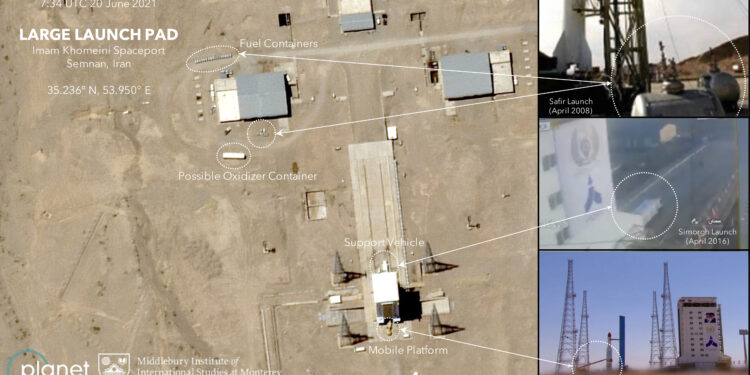Iran seems, by all accounts, to be getting ready for a space dispatch as arrangements proceed in Vienna over its worn out atomic arrangement with world powers, as per a specialist and satellite pictures. (Expert suggest Iranian)
The probably take off at Iran’s Imam Khomeini Spaceport comes as Iranian state media has offered a rundown of forthcoming arranged satellite dispatches in progress for the Islamic Republic’s non military personnel space program, which has been plagued by a progression of fizzled dispatches. Iran’s paramilitary Revolutionary Guard runs its own equal program that effectively set a satellite into space last year.
Directing a dispatch in the midst of the Vienna talks fits the firm stance act struck by Tehran’s arbitrators, who previously depicted six past rounds of strategy as a “draft,” bothering Western countries. Germany’s new unfamiliar priest has ventured to caution that “time is expiring for us now.”
However, this squeezes into a reestablished center around space by Iran‘s firm stance President Ebrahim Raisi, said Jeffrey Lewis, a specialist at the James Martin Center for Nonproliferation Studies at the Middlebury Institute of International Studies who concentrates on Tehran’s program. With Iran’s previous President Hassan Rouhani who shepherded the atomic arrangement out of office, worries about distancing the discussions with dispatches that the U.S. affirms helps Tehran’s long range rocket program probably have blurred.
“They’re not treading lightly,” Lewis said. “I believe Raisi’s kin have another equilibrium as a top priority.”
Iranian state media didn’t recognize the movement at the spaceport and Iran’s central goal to the United Nations didn’t react to a solicitation for input. The U.S. military, which tracks space dispatches, didn’t react to demands for input.
Satellite pictures taken Saturday via Planet Labs Inc. gotten by The Associated Press show action at the spaceport in the desert fields of Iran’s country Semnan region, about 240 kilometers (150 miles) southeast of Tehran. (Expert suggest Iranian)
A help vehicle stood left close by an enormous white gantry that normally houses a rocket on the platform. That help vehicle has showed up in other satellite photographs at the site only in front of a dispatch. Likewise noticeable is a pressure driven crane with a railed stage, additionally seen before past dispatches and reasonable used to support the rocket.
Other satellite pictures as of late at the spaceport have shown an expansion in the quantity of vehicles at the office, one more indication of elevated movement that commonly goes before a dispatch. A structure likewise accepted to be the “checkout” office for a rocket has seen expanded movement also, Lewis said.
“This is genuinely customary pre-dispatch action,” he told the AP.
The movement comes later Iran’s state-run IRNA news office on Dec. 5 distributed an article saying its space program had four satellites prepared for dispatch. It depicted one, the low-circle imaging satellite Zafar, as being “under the last period of readiness.” Zafar, which signifies “triumph” in Farsi, gauges somewhere in the range of 113 kilograms (250 pounds). (Expert suggest Iranian)
The Zafar, in any case, neglected to enter circle later a February 2020 dispatch at the spaceport. That dispatch utilized a Simorgh, or “Phoenix,” rocket, yet it neglected to place the satellite into space at the right speed, as per Iranian authorities at that point. Iran had spent just shy of 2 million euros to fabricate the satellite.
Iran’s regular citizen space program has seen a progression of mishaps and lethal blasts plague it as of late. One baffling impact even grabbed the eye of then-President Donald Trump in 2019, who tweeted out what gave off an impression of being a grouped U.S. spy satellite image of the blast’s outcome with the inscription: “The United States of America was not associated with the disastrous mishap.”
In the mean time, the Guard in April 2020 uncovered its own mysterious space program by effectively dispatching a satellite into space. The top of the U.S. Space Command later excused the satellite as “a tumbling webcam in space” that wouldn’t give Iran indispensable knowledge — however it showed Tehran’s capacity to effectively get into space. (Expert suggest Iranian)
Over the previous decade, Iran has sent a few fleeting satellites into space and in 2013 dispatched a monkey into space. In any case, under Raisi, Iran’s Supreme Council of Space has met without precedent for 11 years, as indicated by a new report by state-run TV.
Raisi said at the November meeting that it “shows the assurance of this administration to foster the space business.” A high-positioning individual from the Guard who runs its aviation program, Gen. Amir Ali Hajizadeh, went to the gathering alongside Foreign Minister Hossein Amirabdollahian.
The U.S. charges such satellite dispatches resist a U.N. Security Council goal approaching Iran to embrace no action identified with long range rockets equipped for conveying atomic weapons. (Expert suggest Iranian)
Iran, which long has said it doesn’t look for atomic weapons, keeps up with its satellite dispatches and rocket tests don’t have a tactical part. Tehran additionally says it hasn’t disregarded the U.N. goal as it as it were “called upon” Tehran not to lead such tests.
However, the conceivable dispatch likewise comes as pressures again ascend over Iran’s atomic program. Since Trump singularly pulled out America from Tehran’s atomic accord with world powers in 2018, Iran gradually deserted every one of the limits the arrangement put on its program.
Today, Tehran improves uranium up to 60% virtue — a short specialized advance from weapons-grade levels of 90%. Its reserve of enhanced uranium additionally proceeds to develop and global auditors face difficulties in checking its advances.
Lewis said he hopes to see the space program speed up given Raisi’s advantage.
“They’re not compelled by stresses over the Iran bargain similarly that Rouhani was,” he said.









